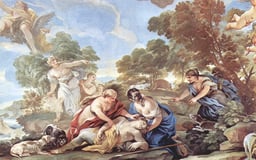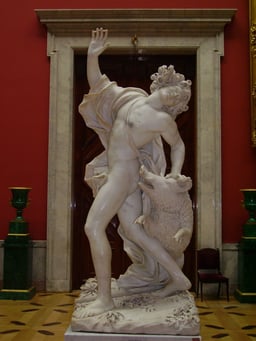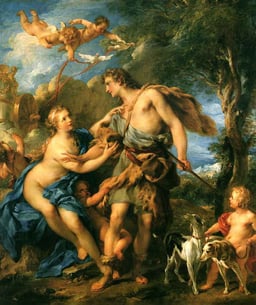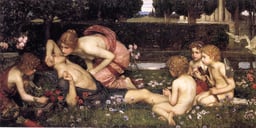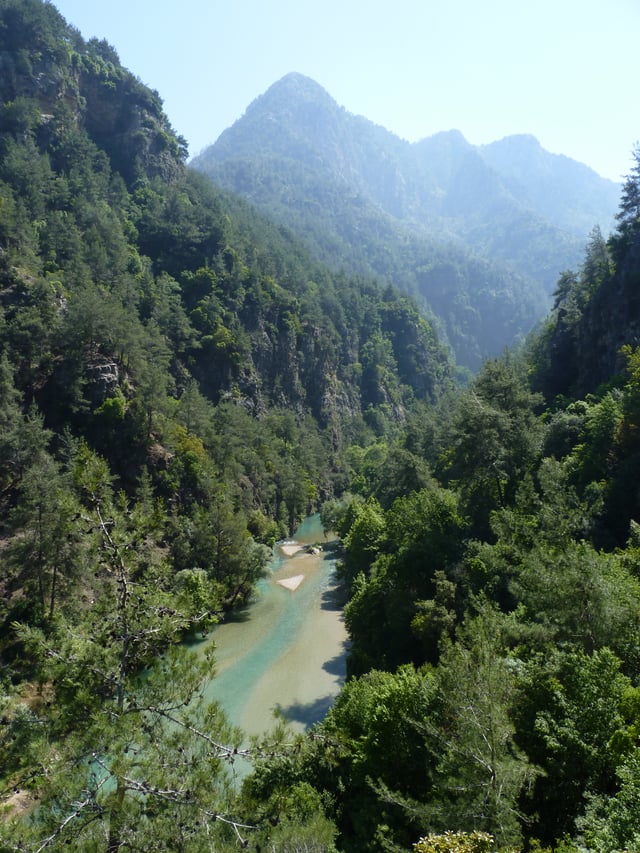Adonis
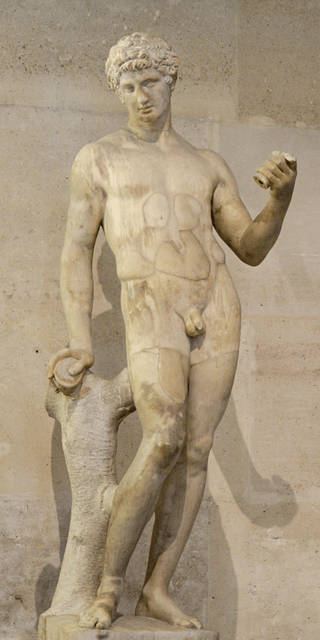
Adonis

| Adonis | |
|---|---|
God of beauty, desire and vegetation | |
| Abode | Lebanon |
| Symbol | anemones, as well as lettuce, fennel, and other fast-growing plants |
| Personal information | |
| Spouse | Aphrodite |
| Children | Golgos, Beroe |
| Parents | Cinyras and Myrrha (by Ovid), Phoenix and Alphesiboea (by Hesiod) |
| Equivalents | |
| Mesopotamian equivalent | Dumuzid, Tammuz |
| Levantine/Canaanite equivalent | Tammuz, Adonis |
Adonis[1] was the mortal lover of the goddess Aphrodite in Greek mythology. In Ovid's first-century AD telling of the myth, he was conceived after Aphrodite cursed his mother Myrrha to lust after her own father, King Cinyras of Cyprus. Myrrha had sex with her father in complete darkness for nine nights, but he discovered her identity and chased her with a sword. The gods transformed her into a myrrh tree and, in the form of a tree, she gave birth to Adonis. Aphrodite found the infant and gave him to be raised by Persephone, the queen of the Underworld. Adonis grew into an astonishingly handsome young man, causing Aphrodite and Persephone to feud over him, with Zeus eventually decreeing that Adonis would spend one third of the year in the Underworld with Persephone, one third of the year with Aphrodite, and the final third of the year with whomever he chose. Adonis chose to spend his final third of the year with Aphrodite.
One day, Adonis was gored by a wild boar during a hunting trip and died in Aphrodite's arms as she wept. His blood mingled with her tears and became the anemone flower. Aphrodite declared the Adonia festival commemorating his tragic death, which was celebrated by women every year in midsummer. During this festival, Greek women would plant "gardens of Adonis", small pots containing fast-growing plants, which they would set on top of their houses in the hot sun. The plants would sprout, but soon wither and die. Then the women would mourn the death of Adonis, tearing their clothes and beating their breasts in a public display of grief. The Greeks considered Adonis's cult to be of Oriental origin. Adonis's name comes from a Canaanite word meaning "lord" and modern scholars consider the story of Aphrodite and Adonis to be derived from the earlier Mesopotamian myth of Inanna (Ishtar) and Dumuzid (Tammuz).
In late nineteenth and early twentieth century scholarship of religion, Adonis was widely seen as a prime example of the archetypal dying-and-rising god, but the existence of the "dying-and-rising god" archetype has been largely rejected by modern scholars and its application to Adonis is undermined by the fact that no pre-Christian text ever describes Adonis as rising from the dead and the only possible references to his resurrection are late, ambiguous allusions made by Christian writers. His name is often applied in modern times to handsome youths, of whom he is the archetype.
| Adonis | |
|---|---|
God of beauty, desire and vegetation | |
| Abode | Lebanon |
| Symbol | anemones, as well as lettuce, fennel, and other fast-growing plants |
| Personal information | |
| Spouse | Aphrodite |
| Children | Golgos, Beroe |
| Parents | Cinyras and Myrrha (by Ovid), Phoenix and Alphesiboea (by Hesiod) |
| Equivalents | |
| Mesopotamian equivalent | Dumuzid, Tammuz |
| Levantine/Canaanite equivalent | Tammuz, Adonis |
Origin
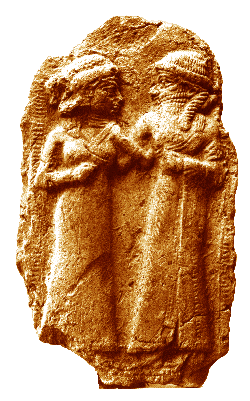
An ancient Sumerian depiction of the marriage of Inanna and Dumuzid[8]
The myth of Aphrodite and Adonis is probably derived from the ancient Sumerian legend of Inanna and Dumuzid.[7][9][4] The Greek name Ἄδωνις (Ádōnis), Greek pronunciation: [ádɔːnis]) is derived from the Canaanite word ʼadōn, meaning "lord".[3][4][10][6][7] This word is related to Adonai (Hebrew: אֲדֹנָי), one of the titles used to refer to the God of the Hebrew Bible and still used in Judaism to the present day.[6] The Syrian name for Adonis is Gaus.[11]
The cult of Inanna and Dumuzid may have been introduced to the Kingdom of Judah during the reign of King Manasseh.[12] Ezekiel 8:14 [56] mentions Adonis under his earlier East Semitic name Tammuz[13][14] and describes a group of women mourning Tammuz's death while sitting near the north gate of the Temple in Jerusalem.[13][14]
The earliest known Greek reference to Adonis comes from a fragment of a poem by the Lesbian poet Sappho (c. 630 – c. 570 BC),[15] in which a chorus of young girls asks Aphrodite what they can do to mourn Adonis's death.[15] Aphrodite replies that they must beat their breasts and tear their tunics.[15] The cult of Adonis has also been described as corresponding to the cult of the Phoenician god Baal.[7] As Walter Burkert explains:
Women sit by the gate weeping for Tammuz, or they offer incense to Baal on roof-tops and plant pleasant plants. These are the very features of the Adonis legend: which is celebrated on flat roof-tops on which sherds sown with quickly germinating green salading are placed, Adonis gardens... the climax is loud lamentation for the dead god.[16]
The exact date when the legend of Adonis became integrated into Greek culture is still disputed. Walter Burkert questions whether Adonis had not from the very beginning come to Greece with Aphrodite.[16] "In Greece," Burkert concludes, "the special function of the Adonis legend is as an opportunity for the unbridled expression of emotion in the strictly circumscribed life of women, in contrast to the rigid order of polis and family with the official women's festivals in honour of Demeter." Both Greek and Near Eastern scholars have questioned this connection.[16]
Myth
Ovid's Metamorphoses

Attic red-figure aryballos painting by Aison (c. 410 BC) showing Adonis consorting with Aphrodite
While Sappho does not describe the myth of Adonis, later sources flesh out the details.[17] According to the retelling of the story found in the poem Metamorphoses by the Roman poet Ovid (43 BC – 17/18 AD), Adonis was the son of Myrrha, who was cursed by Aphrodite with insatiable lust for her own father, King Cinyras of Cyprus,[18] [19][20] after Myrrha's mother bragged that her daughter was more beautiful than the goddess.[18][19] Driven out after becoming pregnant, Myrrha was changed into a myrrh tree, but still gave birth to Adonis.[18][21][22] According to classicist William F. Hansen, the story of how Adonis was conceived falls in line with the conventional ideas about sex and gender that were prevalent in the classical world, since the Greeks and Romans believed that women, such as Adonis's mother Myrrha, were less capable of controlling their primal wants and passions than men.[23]
Aphrodite found the baby,[24] and took him to the underworld to be fostered by Persephone.[24] She returned for him once he was grown[24] and discovered him to be strikingly handsome.[24] Persephone wanted to keep Adonis;[24] Zeus settled the dispute by decreeing that Adonis would spend one third of the year with Aphrodite, one third with Persephone, and one third with whomever he chose.[24] Adonis chose Aphrodite, and they remained constantly together.[24]
Then, one day while Adonis was out hunting, he was wounded by a wild boar, and bled to death in Aphrodite's arms.[24] In different versions of the story, the boar was either sent by Ares, who was jealous that Aphrodite was spending so much time with Adonis,[25] by Artemis, who wanted revenge against Aphrodite for having killed her devoted follower Hippolytus,[25] or by Apollo, to punish Aphrodite for blinding his son Erymanthus.[26] The story also provides an etiology for Aphrodite's associations with certain flowers.[25] Reportedly, as she mourned Adonis's death, she caused anemones to grow wherever his blood fell,[24][25] and declared a festival on the anniversary of his death.[24]
Other versions
In Idyll 15 by the early third-century BC Greek bucolic poet Theocritus, Adonis is described as a still an adolescent with down on his cheeks at the time of his love affair with Aphrodite, in contrast to Ovid's Metamorphoses in which he is portrayed as a fully mature man.[27] Pseudo-Apollodorus (Bibliotheke, 3.182) describes Adonis as the son of Cinyras, of Paphos on Cyprus, and Metharme. According to Pseudo-Apollodorus's Bibliotheke, Hesiod, in an unknown work that does not survive, made of him the son of Phoenix and the otherwise unidentified Alphesiboea.[28]
In one version of the story, Aphrodite injured herself on a thorn from a rose bush[25] and the rose, which had previously been white, was stained red by her blood.[25] The third century BC poet Euphorion of Chalcis remarked in his Hyacinth that "Only Cocytus washed the wounds of Adonis".[29] According to Lucian's De Dea Syria,[30] each year during the festival of Adonis, the Adonis River in Lebanon (now known as the Abraham River) ran red with blood.[24]
Cult
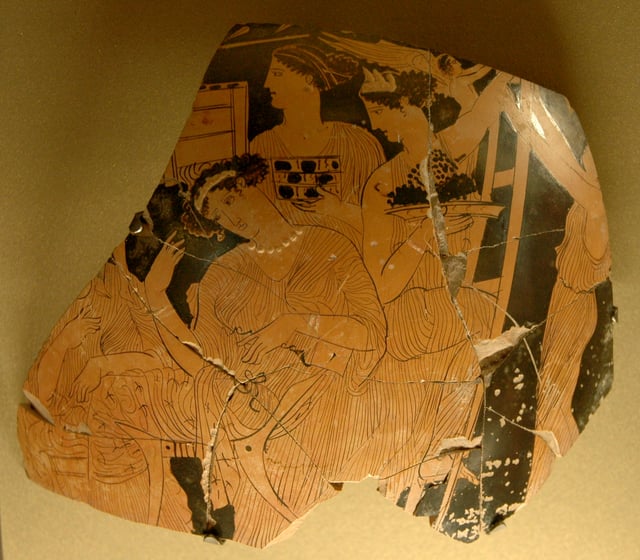
Fragment of an Attic red-figure wedding vase (c. 430–420 BC), showing women climbing ladders up to the roofs of their houses carrying "gardens of Adonis"
The myth of Adonis is associated with the festival of the Adonia, which was celebrated by Greek women every year in midsummer.[4][31] The festival, which was evidently already celebrated in Lesbos by Sappho's time, seems to have first become popular in Athens in the mid-fifth century BC.[4][3] At the start of the festival, the women would plant a "garden of Adonis", a small garden planted inside a small basket or a shallow piece of broken pottery containing a variety of quick-growing plants, such as lettuce and fennel, or even quick-sprouting grains such as wheat and barley.[4][32][16] The women would then climb ladders to the roofs of their houses, where they would place the gardens out under the heat of the summer sun.[4][16]
The plants would sprout in the sunlight, but wither quickly in the heat.[33] While they waited for the plants to first sprout and then wither, the women would burn incense to Adonis.[16] Once the plants had withered, the women would mourn and lament loudly over the death of Adonis, tearing their clothes and beating their breasts in a public display of grief.[34][16] The women would lay a statuette of Adonis out on a bier and then carry it to the sea along with all the withered plants as a funeral procession.[16] The festival concluded with the women throwing the effigy of Adonis and the withered plants out to sea.[16]
In Cyprus, the cult of Adonis gradually superseded that of Cinyras. W. Atallah suggests that the later Hellenistic myth of Adonis represents the conflation of two independent traditions.[35]
Dying-and-rising god archetype
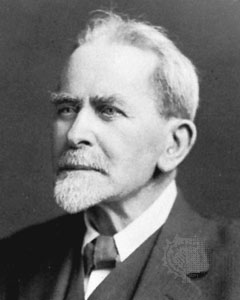
Photograph of Sir James George Frazer, the anthropologist who is most directly responsible for promoting the concept of a "dying and rising god" archetype[36][37][38]
The late nineteenth-century Scottish anthropologist Sir James George Frazer wrote extensively about Adonis in his monumental study of comparative religion The Golden Bough (the first edition of which was published in 1890)[36][39] as well as in later works.[40] Frazer claimed that Adonis was just one example of the archetype of a "dying-and-rising god" found throughout all cultures.[37][36][41] Frazer's main intention was to prove that all religions were fundamentally the same[42] and that all the essential features of Christianity could be found in earlier religions.[43] Frazer's arguments were criticized as sloppy and amateurish from the beginning,[37] but his claims became widely influential in late-nineteenth- and early-twentieth-century scholarship of religion.[37][38][36]
In the mid-twentieth century, scholars began to severely criticize the designation of "dying-and-rising god".[40][44][45] In 1987, Jonathan Z. Smith concluded in Mircea Eliade's Encyclopedia of Religion that "The category of dying and rising gods, once a major topic of scholarly investigation, must now be understood to have been largely a misnomer based on imaginative reconstructions and exceedingly late or highly ambiguous texts."[44][46] He further argued that the deities previously referred to as "dying-and-rising" would be better termed separately as "dying gods" and "disappearing gods",[44][45] asserting that before Christianity, the two categories were distinct and gods who "died" did not return, and those who returned never truly "died".[44][45] By the end of the twentieth century, most scholars had come to agree that the notion of a "dying-and-rising god" was an invention[47][38][48] and that the term was not a useful scholarly designation.[47][38][48]
The foremost problem with the application of the label "dying-and-rising god" to Adonis is the fact that he is never described as rising from the dead in any extant Classical Greek writings.[46][16] The only possible allusions to Adonis's supposed resurrection come from late, highly ambiguous statements made by Christian authors.[46][2] The part of Adonis's myth in which he spends a third of the year in the Underworld with Persephone is not a death and resurrection,[46] but merely an instance of a living person staying in the Underworld.[46]
Post-classical culture
The medieval French poet Jean de Meun retells the story of Adonis in his additions to the Roman de la Rose, written in around 1275.[27] De Muen moralizes the story, using it as an example of how men should heed the warnings of the women they love.[27] In Pierre de Ronsard's poem "Adonis" (1563), Venus laments that Adonis did not heed her warning, but ultimately blames herself for his death, declaring, "In need my counsel failed you."[27] In the same poem, however, Venus quickly finds another shepherd as her lover, representing the widespread medieval belief in the fickleness and mutability of women.[27]
The story of Venus and Adonis from Ovid's Metamorphoses was tremendously influential during the Elizabethan era.[49] In Edmund Spenser's epic poem The Faerie Queene (1590), tapestries depicting the story of Adonis decorate the walls of Castle Joyous.[27] Later in the poem, Venus takes the character Amoretta to raise her in the "Garden of Adonis".[27] Ovid's portrayal of Venus's desperate love for Adonis became the inspiration for many literary portrayals in Elizabethan literature of both male and female courtship.[49]
William Shakespeare's erotic narrative poem Venus and Adonis (1593), a retelling of the courtship of Aphrodite and Adonis from Ovid's Metamorphoses,[50][51] was the most popular of all his works published within his own lifetime.[52][53] Six editions of it were published before Shakespeare's death (more than any of his other works)[53] and it enjoyed particularly strong popularity among young adults.[52] In 1605, Richard Barnfield lauded it, declaring that the poem had placed Shakespeare's name "in fames immortall Booke".[53] Despite this, the poem has received mixed reception from modern critics.[52] Samuel Taylor Coleridge defended it, but Samuel Butler complained that it bored him and C. S. Lewis described an attempted reading of it as "suffocating".[52]
The story of Adonis was the inspiration for the Italian poet Giambattista Marino to write his mythological epic L'Adone (1623), which outsold Shakespeare's First Folio.[27] Marino's poem focuses on the pleasures of love, which it describes explicitly.[27] It describes Adonis as shooting the boar with Cupid's arrow and proclaims the tusk that crushes his hip a "loving" one.[27] Shakespeare's homoerotic descriptions of Adonis's beauty and Venus's masculine pursuit of him inspired the French novelist and playwright Rachilde (Marguerite Vallette-Eymery) to write her erotic novel Monsieur Vénus (1884), about a noblewoman named Raoule de Vénérande who sexually pursues a young, effeminate man named Jacques who works in a flower shop.[54] Jacques is ultimately shot and killed in a duel, thus following the model of Adonis's tragic death.[54]
See also
Adonia, feasts celebrating Adonis
Adonism
Apheca
Myrrha, mother of Adonis per Greek mythology
Adonis belt
Psychology:
Muscle dysmorphia, as part of Adonis Complex
Theorizing about Myth, a Jungian interpretation of the Adonis myth by R. Segal


